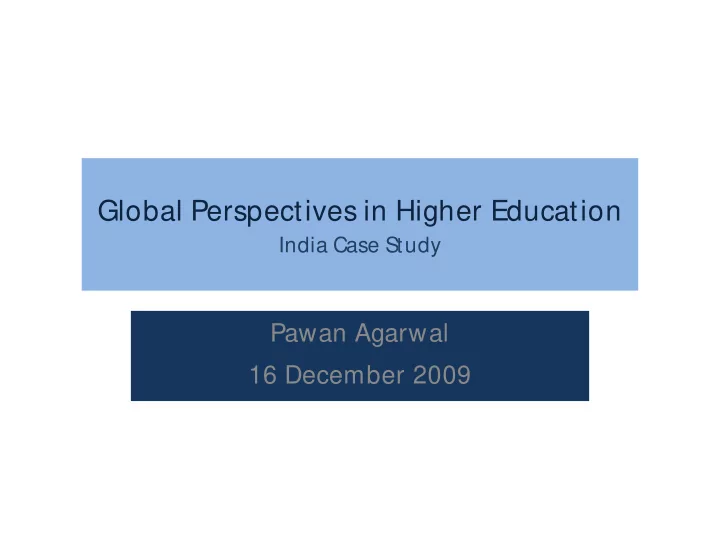

Global Perspectives in Higher Education India Case Study Pawan Agarwal 16 December 2009
Scope India Indian higher education Organizing principles & getting it right 2
India: Size and contradictions Demography Higher Education Future • Population - 1166 • 13 million • Highest million population by • GER – 12.8% 2028 • Large and • Largest number growing middle • 540 million of institutions – class middle class by both huge and 2025 • Large population tiny with English • Continuing • Second largest language skills growth,, but also exporter, but unmet demand small imports 3
Population, 2009 (in million) Source: CIA Fact book (retrieved on 9 Dec 2009) 4
Economy 2008 (PPP basis) Source: CIA Fact book (retrieved on 9 Dec 2009)
Rising prosperity (million households) Source: India: The Bird of Gold, M ckinsey, 2007
India Indian higher education 7
Higher education: USA / India Size and complexity • Order within chaos / Growth creating more complexity Open democracy with federal set up • Indirect, but powerful role of the Federal Govt./ Direct, but ineffective role of National Govt. Coordination • M arket - government / government - market Private participation • Long history, elite / Recent growth, demand-absorbing 8
Size and Prospects: 2009-2020 12.8 m 30 m Enrolment GER -13 % GER – 30 % Universities Universities Institutions 500 1500 Colleges 22000 Colleges 30000 Private 30% 50% share 3.8 m 15 m 9
Private participation Demand absorbing • Public sector growth – slow and more of the same Expensive, single discipline • Engineering, management … . Small entities • Average – 500/ 600 students 10
Current trends Expansion by the old privates • BITS, Pilani, Thapar Emergence private chains • Amity, Techno-India, Career Launcher… Big corporate sector interest • Ambanis, M ittals… Hybrids • Jaypee Group, Apeejay Niche • NIIT University, Vedanta University 11
Streaming Class 12 BA / M A Arts BSc / M Sc Class 12 BE Class 10 (Engineering) Science M BBS (M edicine) Class 12 Bcom / M com Commerce Certificate (ITIs) Vocational Stream Diploma (Polytechnics) 12
Institutional structures Overall Institutions 23000 IITs / IIMs / State Central Private State Degree-granting Other affiliating Universities universities universities Institutions univs Colleges Colleges Colleges Private Colleges (teaching only) funded by funded by funded by colleges central govt state govts state govts 13
Institutions • Unitary / affiliating • Arts and science / • IIT professional • Central / State • IIM • Regular / autonomous • Conventional / Open • AIIM S • Govt. / private / private • M ulti-disciplinary / • NIFT aided Single discipline • National Law School • Public / private Other Universities Colleges Institutions • Govt / private • Franchise / standalone Polytechnics Private training and ITIs providers 14
M aintaining standards Regulation Accreditation • National govt • National Accreditation and Assessment Council • State govt (NAAC) • UGC • National Board of • State Councils of HE Accreditation (NBA) • AICTE • Accreditation Board • M ed Council • • Other 10 councils • Affiliating universities 15
Four concerns Alignment Funding Standards Growth Govt sector Unsettled debate Drift to lowering of marginal growth Low priority until on purpose standards over past 2- recently decades No drive for growth Accreditation Input-based in existing M ore of the same system with no funding system institutions impact Unable to connect Absence of other Private sector Private growth to national institutional growth – equity priorities mechanisms concerns 16
India: In Context Indian higher education Organizing principles 17
Two organizing principles US M arket-led system Primacy of competition Coordination by means of voluntary non-state linkages Diversified sources of funding UK Govt-led system Quasi-competition through performance-based funding Coordination through QA agencies and NQF / SBC Greater reliance on tuition and student loans 18
The Triangle of coordination USA / UK India Academic M arket Oligarchy Source: Adapted from M odel by Burton R. Clark 19
Academic oligarchy Academic freedom Defined Exercise Full autonomy according to Continued influence in academic disciplines / fragmentation through peer work subjects groups But do not transmute this local authority in the state / national systems… .that would create academic anarchy 20
Four ways to get it right • Use public funds to drive performance – relevance, growth, equity, research and quality 1 • Regulate the private sector the right way that creates incentives to grow and maintain and enhance standards 2 • Connect the vocational education and training (both public and private) with higher education for holistic treatment of the tertiary sector 3 • Consolidate and classify institutions for critical mass 4 21
Relative growth in volume of publications 1981=100 Source: The Global Research Report: India, 2009 22
Top 200 World Universities Ra University Peer Employ Staff / Citatio Interna Interna Overall nk Review er Studen n / tional tional Review t Ratio Staff Staff Studen ts 49 Tsinghua 98 83 95 34 45 34 78.9 52 NYU 94 94 75 53 26 52 78.4 52 Peking 100 93 89 35 24 30 78.4 163 IIT Bombay 76 79 43 45 16 13 58.6 181 IIT Delhi 68 81 46 48 15 13 56.4 Source: Times Higher Education-QS World University Ranking 2009 23
… .to summarize … .and if a few things are set right one of India would the best and have largest most system of affordable higher education 24
Recommend
More recommend